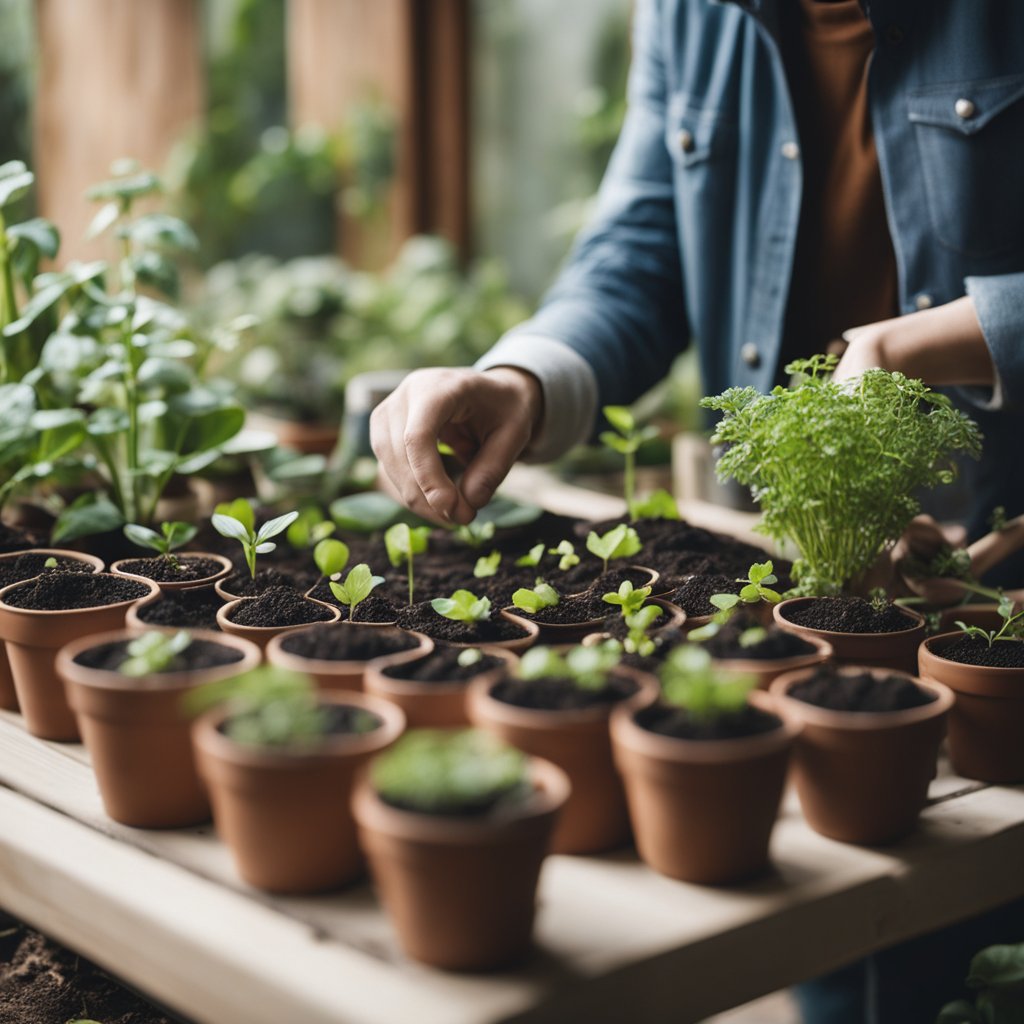How to Start a Small Home Garden with Minimal Effort: A Simple Guide for Beginners
By Alex Reynolds |

How to Start a Small Home Garden with Minimal Effort: A Simple Guide for Beginners
Starting a small home garden can seem daunting, but it is easier than many think. He or she can begin by choosing easy-to-grow plants, preparing a small space, and using simple tools to maintain the garden. With just a little planning and the right approach, anyone can enjoy fresh produce right from their backyard.
A small garden has many benefits, including saving money on groceries and enjoying the satisfaction of growing food. Beginners can start with a few pots or a small patch of soil, focusing on herbs or vegetables that do well in limited space. This method not only simplifies the gardening process but also encourages a rewarding hobby that promotes sustainability.
Minimal effort does not mean sacrificing results. Choosing low-maintenance plants and using efficient techniques can lead to a thriving garden. With practical tips and a clear roadmap, anyone can cultivate their own green space.
Assessing Your Space
Assessing the available space for a home garden is crucial for success. Key factors include sunlight exposure and soil quality, which can significantly impact plant growth.
Evaluating Sunlight and Shade
Sunlight is essential for plant growth. It is important to determine how much sunlight the chosen area receives throughout the day.
- Full Sun: Areas that receive at least 6-8 hours of direct sunlight. These spots are ideal for most vegetables and herbs.
- Partial Shade: Locations that get 4-6 hours of sunlight. Suitable for shade-tolerant plants like lettuce and spinach.
- Full Shade: Areas with less than 4 hours of sunlight. Limited options are available, mainly for leafy greens and some herbs.
To evaluate sunlight, observe the garden space at different times of day. Mark areas that receive varying amounts of sunlight. This will help in selecting the right plants for the right spots.
Considering Soil Quality
Soil quality is another critical factor when starting a garden. Healthy soil provides essential nutrients for plants.
To assess soil quality, consider the following:
- Texture: Check if the soil is sandy, loamy, or clayey. Loamy soil is ideal as it retains moisture while draining excess.
- pH Level: Most vegetables prefer a slightly acidic to neutral pH (6.0 to 7.0). Home test kits are available for easy measurement.
- Nutrient Content: Look for organic matter like compost to enrich the soil. This improves fertility and supports plant growth.
Before planting, improve the soil by adding compost or organic fertilizers as needed. This ensures a strong start for the garden.
Planning Your Garden Layout
Creating a good garden layout is key to a successful small home garden. This involves choosing a design that fits space and needs, and selecting plants suited to the local climate.
Choosing a Garden Style
There are several styles to choose from when planning a garden. Here are a few popular options:
- Raised Beds: These provide better drainage and make it easier to manage soil quality. They also reduce bending when planting or weeding.
- Container Gardening: Using pots allows flexibility. This is great for small spaces or patios. It also lets gardeners move plants to catch the right amount of sunlight.
- Vertical Gardens: These save space and add visual interest. They are suitable for herbs or small vegetables, making use of walls or fences.
Selecting the right style helps in maximizing space and ease of maintenance.
Selecting Plants for Your Climate
Choosing plants that suit the local climate is crucial. Here’s how to pick wisely:
- Know Your Hardiness Zone: This indicates which plants will thrive in your area. Check local agricultural resources for specific zones.
- Consider Sunlight: Some plants need full sun, while others prefer partial shade. Assess the available sunlight in your garden area.
- Choose Native Plants: Local plants usually require less water and are more resistant to pests. They also benefit local wildlife.
- Seasonality: Plan for plants that can be grown in different seasons. Include both cool-proof and warm-weather crops for year-round enjoyment.
By focusing on appropriate plants, a gardener can create a flourishing space with minimal effort.
Gathering Essential Supplies
To create a small home garden with minimal effort, it is crucial to gather the right supplies. These include basic tools for beginners and understanding soil and composting. Having the necessary items ready can simplify the gardening process.
Basic Tools for Beginners
A few essential tools can make gardening easier and more efficient. Here are the most important items to consider:
- Gardening Gloves: Protects hands from dirt and scratches.
- Hand Trowel: Ideal for digging small holes and transplanting seedlings.
- Pruners: Useful for trimming plants and removing dead growth.
- Watering Can or Hose: Ensures plants receive the right amount of water.
For beginners, a gardening kit often includes these tools. This makes starting a garden less daunting. It’s advisable to invest in sturdy tools that won’t break easily. With these basics, any beginner can start planting with confidence.
Soil and Composting Basics
Healthy soil is vital for a thriving garden. Start with good quality potting soil or topsoil. Look for soil that is rich in organic material and nutrients.
Composting can greatly enhance soil quality. Here are some steps to begin composting:
- Choose a Compost Bin: This can be a store-bought bin or a homemade one.
- Gather Materials: Use kitchen scraps like fruit peels and vegetable trimmings, along with yard waste such as leaves and grass clippings.
- Turn the Pile: Every few weeks, mix the compost to aerate it.
By understanding soil and composting, a gardener can create conditions that promote growth. This simple process encourages less effort and better results in the garden.
Planting Your Garden
When starting a small home garden, choosing between seedlings and seeds is crucial. Additionally, knowing effective planting techniques will influence the success of the garden.
Starting with Seedlings vs. Seeds
Seedlings are young plants that are ready to be transplanted. Using seedlings can save time and effort, allowing gardeners to skip the germination process. This is especially helpful for beginner gardeners or those wanting quick results.
On the other hand, seeds offer a wider variety of plants and can be more cost-effective. They require more care initially, such as proper spacing and watering for germination. Seeds can also provide personal satisfaction as they grow from the very beginning.
For those who choose seeds, planting at the right time according to local weather conditions is essential. These factors can affect growth and yield.
Planting Techniques
Proper planting techniques are vital for a thriving garden. Begin by preparing the soil, making sure it is loose and enriched with compost. Testing the soil’s pH can also help determine which plants will grow best.
When planting, keep in mind the spacing requirements for each type of plant. For example:
- Root vegetables like carrots need about 2-4 inches apart.
- Leafy greens such as lettuce thrive when spaced 8-12 inches apart.
Watering after planting is crucial. It helps settle the soil around the seeds or seedlings. Applying mulch can help retain moisture and suppress weeds. Following these techniques will make for a healthier garden with minimal effort.
Maintaining Your Garden with Ease
Maintaining a garden can be simple and enjoyable with the right practices. Proper watering and weed management are key to keeping a garden thriving without too much effort.
Watering Wisely
Watering is essential for plant health, but timing and method can make it easier. It is best to water early in the morning or late in the afternoon to reduce evaporation.
Plants generally need about 1 inch of water per week. A rain gauge can help measure rainfall and avoid overwatering.
Using a soaker hose allows water to seep into the soil slowly and deeply. This technique lowers the risk of fungal diseases that can develop from wet leaves.
Tip: Mulching can reduce water needs by keeping the soil cool and moist.
Mulching and Weed Control
Mulch acts as a barrier, preventing weeds while retaining moisture. Organic mulches like straw or wood chips are excellent options. They can decompose over time, adding nutrients back into the soil.
A layer of 2 to 4 inches of mulch is effective for most gardens.
Regular checks for weeds are still necessary, though. Hand-pulling weeds or using a hoe can keep them in check.
Applying mulch around plants reduces competition for nutrients. This promotes healthy growth with minimal effort.
By focusing on watering wisely and effective mulching, maintaining a small home garden becomes a more manageable task.
Troubleshooting Common Problems
Starting a home garden can come with challenges. Tackling pests and diseases early is essential for healthy plants. Here are some effective ways to address these common issues.
Pest Prevention
Preventing pests starts with good garden practices. Keeping the garden clean helps eliminate hiding spots. Removing debris and dead plants reduces pest habitats significantly.
Companion planting is another effective strategy. Certain plants deter pests, such as marigolds, which keep aphids away. Adding beneficial insects, like ladybugs, can help manage pest levels naturally.
Regular checks are important. Inspect leaves, stems, and soil for signs of pests. If something is spotted, remove affected plants immediately. Using organic methods, such as neem oil spray, can also help control infestations without harming beneficial insects.
Disease Management
Plant diseases often arise from poor watering techniques or overcrowding. To prevent this, ensure proper air circulation by spacing plants adequately. Watering in the morning helps reduce humidity on leaves, which can lead to fungal infections.
Recognizing symptoms early is key. Yellowing leaves, spots, or wilting can indicate problems. Reacting quickly with proper care, such as removing diseased leaves, can minimize spread.
Using disease-resistant varieties of plants can offer an edge. Adding mulch helps prevent soil-borne diseases by creating a barrier. Furthermore, practicing crop rotation each season strengthens soil health and reduces recurring issues.
Harvesting and Enjoying Your Produce
Harvesting at the right time is crucial for maximum flavor and nutrition. After gathering produce, proper handling ensures it stays fresh longer. Below are important details about these two aspects.
When to Harvest
Knowing when to harvest is key to enjoying fresh vegetables. Each type of plant has specific signs indicating readiness. For example:
- Tomatoes should be picked when they are fully colored and slightly soft to the touch.
- Lettuce can be harvested when the leaves are large enough to eat, usually around 4-6 weeks after planting.
- Carrots should reach about 1 inch in diameter; pulling them too soon can result in small sizes.
A general rule is to harvest in the morning when temperatures are cooler. This helps preserve flavor and maintain moisture.
Post-Harvest Handling and Storage
After harvesting, proper handling is essential. Start by gently removing dirt by rinsing with water. Avoid soaking, as this can cause spoilage.
Storage methods vary by produce:
- Leafy greens keep best in a damp cloth inside a perforated bag in the fridge.
- Roots like carrots can last in a cool spot covered in moist sand.
- Tomatoes should be stored at room temperature, away from direct sunlight.
Using these simple methods helps maintain quality and maximizes enjoyment of the homegrown harvest. Proper practices ensure the produce remains fresh and tasty for later use.
Expanding Your Garden
Expanding a small home garden can be done in simple steps. This approach ensures efficiency without too much effort.
1. Plan the Layout
Before adding new plants, take time to sketch a layout. This helps visualize which areas might be best for different plants.
2. Choose the Right Plants
Select easy-to-grow plants such as:
- Tomatoes
- Lettuce
- Herbs (like basil and parsley)
These plants thrive well in smaller spaces and can yield plentiful rewards.
3. Use Vertical Space
Utilizing vertical space helps maximize gardening areas. Consider using trellises or hanging pots. They save ground space and create an appealing look.
4. Succession Planting
This technique involves planting new seeds right after the harvest. It allows for continuous crops without overloading the garden at once.
5. Incorporate Containers
Adding container gardens can also expand space. They can be placed on patios, balconies, or even window sills.
6. Companion Planting
Some plants grow better together. For example, pairing beans with corn can encourage growth while saving space.
By following these steps, anyone can effectively expand their home garden with minimal effort, allowing for a diverse and productive gardening experience.
Frequently Asked Questions
Starting a small home garden can be simple with the right approach. Here are some specific questions and answers that address common concerns for beginners.
What are the essential steps to begin a vegetable garden in a small backyard?
To start a vegetable garden, the first step is to choose a sunny spot. Most vegetables require at least six hours of sunlight each day.
Next, prepare the soil by removing weeds and debris. It is important to loosen the soil and enrich it with compost or organic matter.
Finally, select the right vegetables based on the season and local climate. Plant seeds or seedlings following the instructions on the seed packets.
What is the simplest type of garden to start for a beginner?
A container garden is often considered the simplest for beginners. It requires less space and can be placed on patios, balconies, or even windowsills.
Using pots allows for greater control over soil quality and watering. Herbs, lettuce, and radishes are great options to start with.
How can you create a vegetable garden within a limited space or an apartment?
Vertical gardening is effective in small spaces. This involves using shelves, trellises, or wall-mounted planters to grow upward instead of outward.
Another option is to use hanging planters or window boxes to maximize space. Choosing compact vegetable varieties can also help.
What are the best practices for planting a vegetable garden in containers?
Choose containers with good drainage holes. This prevents overwatering, which can harm plants.
Use high-quality potting soil designed for container gardens. Regularly check the moisture level and water as needed.
Fertilizing every few weeks can also keep plants healthy and productive.
How do you initiate a simple and small indoor garden?
Select a well-lit area in the home. South-facing windows are ideal for indoor gardening.
Choose low-maintenance plants, such as herbs or small leafy greens. Using grow lights can assist when natural light is insufficient.
Watering should be done carefully to avoid roots sitting in water.
What layout considerations should beginners keep in mind when planning a small vegetable garden?
Plan for easy access to each plant for watering and harvesting. Rows or raised beds can enhance accessibility.
Consider the mature size of plants to prevent overcrowding. Position taller plants to the north or back of the garden to avoid shading shorter ones.
Using a grid system can help structure the garden space effectively.


